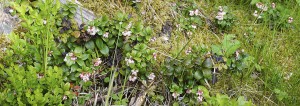The weather has given the coldest May since 1962, 12 years before I started with bees. The bees have had a hard time getting enough pollen to keep up egglaying to reach optimum nectar gathering strength when summer comes.
In agricultural areas winter rape has given some nectar during the few hours with good weather. It’s still in bloom… In the forest small blueberry bushes which in many areas cover the ground has done the same. Now lingonberry flowers give nectar and pollen.
Pollen is essential as amino acid and protein source. These are used for almost every thing the bees need to function as they should, for example the immune system.
This year I’ve seen wingless bees in colonies with no big population of mites, eve if it’s somewhat bigger than it had been if the colonies had been treated with an effective miticide last year. I use thymol only when wingless bees appear, on the hardboard in front of the entrance or on the brood combs.
Nosema have probably also contributed to health problems with the bees this cold May, in combination with viruses and plant protection chemicals, it can be disastrous.
Now sun and mating temperature for honey bee queens came upon us the other day. Nature dried up. The hard boards appeared “empty”. Bees are working like maniacs. Nectar is filling the supers, even in the forest. It must be the lingonberries.
 To the left there is a Swedish blueberry plant showing some berry babies. Now lingonberries are blooming.
To the left there is a Swedish blueberry plant showing some berry babies. Now lingonberries are blooming.
But happiness is not perfect. In most colonies there hasn’t been egglaying as it should this time of the year. The field bees that will fly to death will not all be replaced by hatching new bees. But if the fine weather will continue the bees may collect quite some early honey, in spite of the earlier bad weather. And here in Sweden we hope for a good amount of wild raspberry flowers.